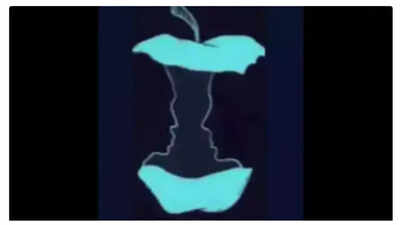Optical illusions are more than just visual tricks; they're a fascinating way to exercise your brain and test your observational skills. These mind-bending images challenge our perception and offer a glimpse into how our minds work. A popular illusion making rounds online can reveal surprising aspects of your personality.
Optical illusions occur because our brains sometimes misinterpret the information our eyes send. This happens when the visual input conflicts with how the brain processes and understands what it sees, leading us to perceive things differently from reality.
What do you see in the image below? An apple core or two faces?

This particular image, shared by Marina Winberg, presents a classic dual-illusion. At first glance, you might notice an eaten apple or two faces looking at each other. According to Winberg, whichever you spot first can reveal a fundamental aspect of your personality.
If you see the two faces first:
Winberg suggests that seeing the two faces indicates you are a logical and analytical thinker with strong morals. You tend to think before acting, value stability, and approach problems with creativity. However, you may find that curiosity sometimes gets the better of you.
If you see the apple first:
Those who immediately perceive the apple core are often intuitive and emotionally aware. You possess a knack for reading subtle cues and know the right thing to say, though you may choose to remain quiet. Stability is important to you, and you are protective of what you value.
There are three primary categories of optical illusions:
Literal Illusions: These illusions occur when the brain combines elements of an image to create a perception that doesn't truly exist. The "two faces or vase" illusion is a prime example.
Physiological Illusions: These illusions result from overstimulation of the visual system. Excessive exposure to light, movement, or color can lead to effects such as afterimages or motion illusions.
Cognitive Illusions: These illusions are rooted in how the brain subconsciously interprets information. The Müller-Lyer illusion, where lines appear to be different lengths due to surrounding shapes, falls into this category.
Newer articles
Older articles
 Emma Raducanu Shuts Down Carlos Alcaraz Dating Rumors with Playful Wimbledon Press Conference Quip
Emma Raducanu Shuts Down Carlos Alcaraz Dating Rumors with Playful Wimbledon Press Conference Quip
 Rishabh Pant's "Revolutionary" Cricket Style Hailed by Greg Chappell
Rishabh Pant's "Revolutionary" Cricket Style Hailed by Greg Chappell
 5 Silent Signals of Prediabetes: Recognize the Warning Signs Before a Blood Test
5 Silent Signals of Prediabetes: Recognize the Warning Signs Before a Blood Test
 Wimbledon 2025: Broadcast Guide for India and US Viewers - Dates, Prize Money, and Streaming Details
Wimbledon 2025: Broadcast Guide for India and US Viewers - Dates, Prize Money, and Streaming Details
 Smith Targets Second Test Return After Innovative New York Rehab
Smith Targets Second Test Return After Innovative New York Rehab
 Gavaskar Calls for Kuldeep Yadav's Inclusion in Second Test Amid Bumrah Fitness Doubts, Cites Birmingham Pitch Advantage
Gavaskar Calls for Kuldeep Yadav's Inclusion in Second Test Amid Bumrah Fitness Doubts, Cites Birmingham Pitch Advantage
 Skin Signals: 7 Unexpected Signs of Heart Disease You Should Know
Skin Signals: 7 Unexpected Signs of Heart Disease You Should Know
 India Poised for Dengue Breakthrough as Vaccine Candidate Nears Trial Completion
India Poised for Dengue Breakthrough as Vaccine Candidate Nears Trial Completion
 Science-Backed Steps to a Healthier Heart: 5 Simple Habits for a Stronger You
Science-Backed Steps to a Healthier Heart: 5 Simple Habits for a Stronger You
 FIFA Club World Cup 2025: Upsets, Messi Magic, and 2026 World Cup Concerns Emerge From Group Stage
FIFA Club World Cup 2025: Upsets, Messi Magic, and 2026 World Cup Concerns Emerge From Group Stage